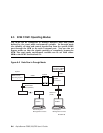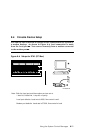
Using the System Control Manager 8-7
Through Mode
Through mode is the default operating mode. The SCM routes every character
of data between the internal system COM1 port and the active external port,
either the local port or the modem port. If a modem is connected, the data goes
to the modem. The SCM filters the data for a specific escape sequence. If it
detects the default escape sequence, “<Esc><Esc>scm”, it enters the SCM CLI.
Figure 8–2 illustrates the data flow in through mode. The internal system
COM1 port is connected to one port of the DUART chip, and the other port is
connected to an external modem port, providing full modem controls. The
DUART is controlled by the SCM microprocessor, which moves characters
between the two UART ports. The local port is always connected to the internal
UARTofthemicroprocessor. TheescapesequencesignalstheSCMtoenterthe
CLI. Data issued from the CLI is transmitted between the SCM microprocessor
and the active port that enters the SCM.
NOTE: The internal system COM1 port should not be confused with the
external COM1 serial port on the standard I/O module. The internal
COM1 port is used by the system software to send data either to the
COM1 port on the system or to the SCM modem port if a modem is
connected.
Local Mode
You can set a local mode in which only the local channel can communicate with
the system COM1 port. In local mode the modem is prevented from sending
characters to the system COM1 port, but you can still enter the SCM from the
modem.


















